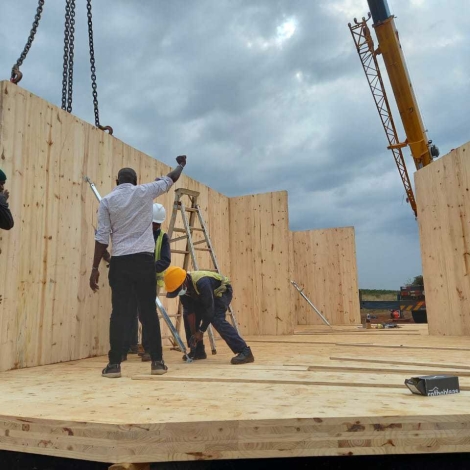Construction, and the concrete and steel used in buildings, account for at least 10 percent of global greenhouse gas emissions. The exact amount varies based on the source, with estimates ranging from 11-13 percent. The “embodied carbon” in construction materials includes emissions from their extraction, manufacture, transport, use in construction and eventual disposal. To green the construction industry, BuildX, a startup operating in Nairobi, Kenya, is developing viable alternatives. The goal is to reduce the carbon footprint, and eventually the cost, of construction in the region.
BuildX’s mass timber are engineered wood products designed as high-strength and lightweight replacements for concrete and steel.
“Mass timber offers performance characteristics superior to high carbon options like concrete and steel, including a greater strength-to-weight ratio, faster build times, better fire performance, and even health and wellbeing benefits,” says James Mitchell, Co-Founder and CEO of BuildX.
The first multiple-storey buildings made with cross-laminated timber, a mass timber product, have gone up in Nairobi. BuildX has also landed partnerships with agroforestry companies to provide a lumber supply that includes FSC-certified sustainable pine. The arrangement brings the costs down for mass timber.
“Builders can get rich building better while not denuding forests,” says Avery Bang, Senior Principal at the Mulago Foundation, who recommended BuildX’s mass timber as one of this year’s Promising Prototypes.
Promising Prototypes to Watch in 2023
Explainer: Mass timber
“Mass timber” is the collective term for a group of materials that include cross laminated timber, glulam engineered wood beams, laminated veneer lumber and others. The products are built with compressed layers of solid wood bonded with fasteners or adhesives to create larger beams or panels.
“Mass timber makes most sense for buildings four stories and above (albeit it can be used for smaller structures, but this is less common and less optimal structurally), and therefore tends to be most successfully used for larger residential and commercial developments, as well as for larger public structures such as schools, hospitals, and airports,” Mr. Mitchell says.
Supply chains underway
Supply chains are the obstacle impeding the replacement of concrete and steel in Kenya’s construction industry. Manufacturing and delivery networks thrive for traditional materials with high carbon footprints, but BuildX has had to forge their own supply chains for mass timber products.
“Even where supply chains for mass timber products exist, they are typically far smaller in scale than global concrete and steel capacity, meaning that the material remains a premium product for now,” Mr. Mitchell says. “That said, in more established markets… there are now examples of large mass timber buildings which have achieved cost parity with traditional building methods.”
BuildX has no manufacturing operations in East Africa, instead relying on imports from South Africa and Europe. The potential for mass timber supply chains in the region is high, however, and BuildX is developing them.
“In Uganda and Tanzania in particular we have a good volume of sustainable (incl. FSC-certified) commercially-grown softwood timber, mostly pine, as well as a growing primary processing capacity (e.g. saw-milling, kiln-drying, etc.) which could readily provide the necessary raw material supply for mass timber products,” Mr. Mitchell says.
Learn more about BuildX at their site: buildxstudio.com.

